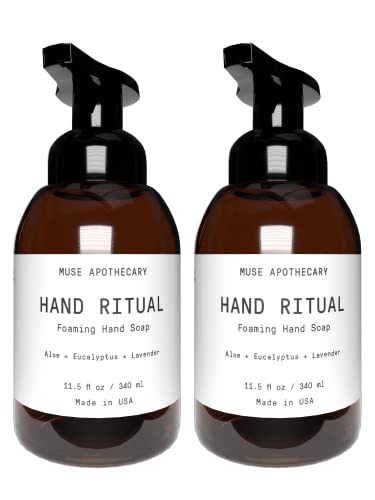
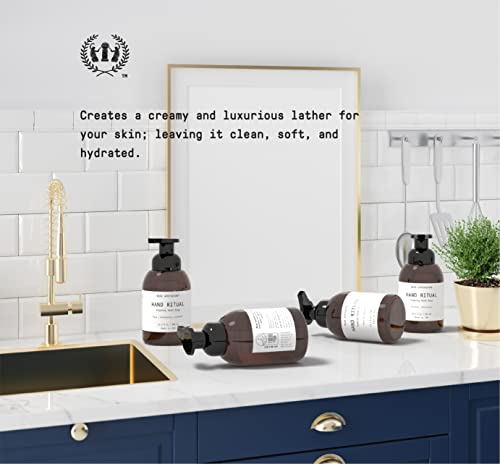
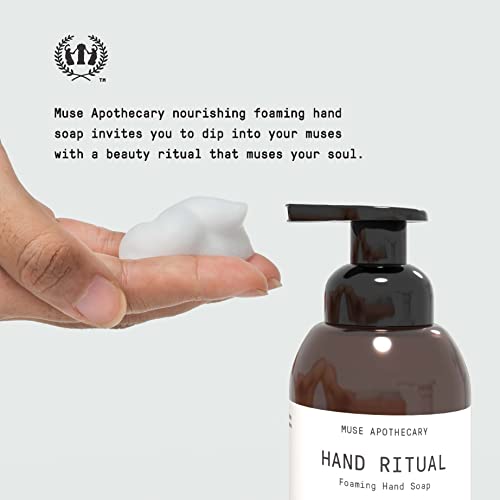
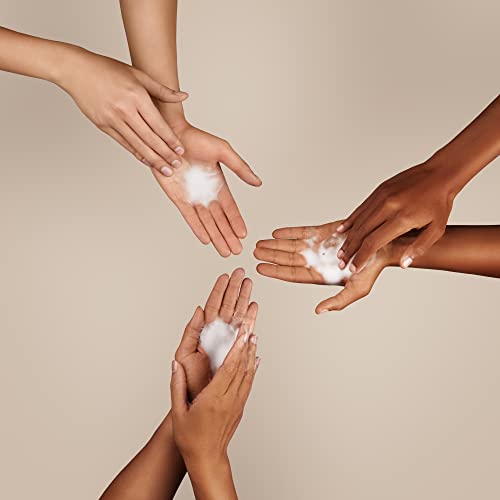
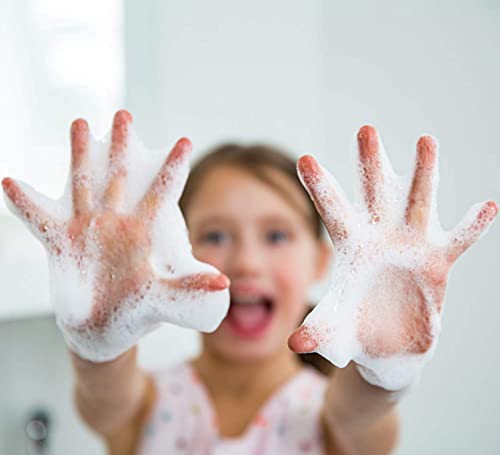
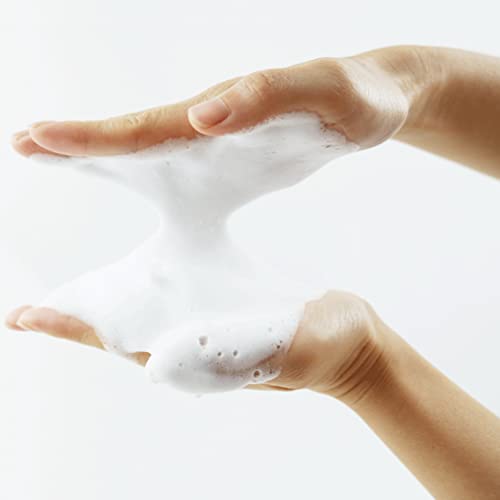
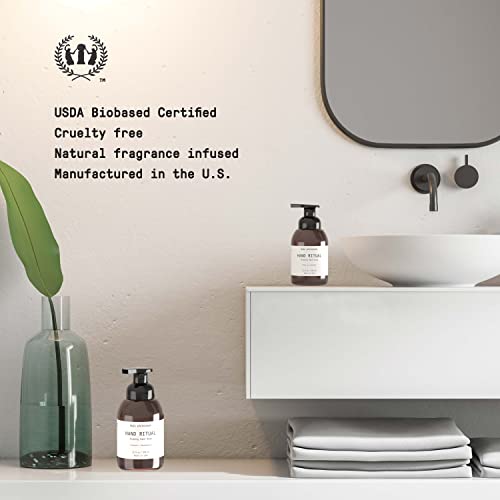
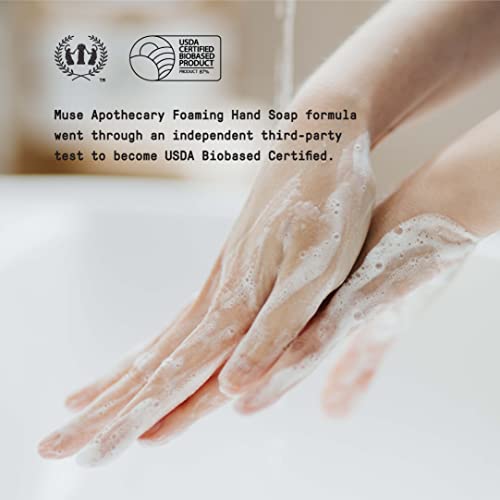
Muse Apothecary Hand Soap - Nourishing Foaming Formula with Essential Oils - 2 Pack, 11.5 oz


Cocamidopropyl Betaine
High RiskCocamidopropyl betaine is a synthetic surfactant derived from coconut oil, commonly used in personal care products for its mild cleansing and foaming properties. It functions as a surfactant, emulsifier, and thickening agent, contributing to the texture and performance of formulations.
Sustai Insights
Cocamidopropyl betaine offers functional benefits as a gentle surfactant, enhancing product foaming and texture. However, it may pose low to moderate allergenic risks and is subject to high use restrictions due to contamination concerns. Regulatory bodies have advised on its safe levels of usage, categorizing its risk level as high overall. Users should practice caution, particularly with sensitive populations, and consider alternatives like naturally derived surfactants for safer formulations.
Methylisothiazolinone
High RiskMethylisothiazolinone is a widely-used preservative in cosmetic and personal care products, known for its antimicrobial properties. It helps prevent the growth of bacteria and fungi, extending the shelf life of formulations. It is often used in leave-on and rinse-off products, including lotions and shampoos.
Sustai Insights
Methylisothiazolinone serves as an effective preservative, combating microbial growth in various personal care items. However, it is associated with a high risk of allergic reactions and skin sensitization, especially in individuals exposed repeatedly. Regulatory bodies have imposed use restrictions due to these health concerns. Additionally, while it is not considered a carcinogen, its environmental impact includes potential pollutant characteristics. Overall, the risk associated with methylisothiazolinone is high, prompting caution and consideration of safer alternatives.
Citric Acid
Medium RiskCitric acid is an alpha hydroxy acid used in personal care products primarily for its role as a pH adjuster and natural preservative. It occurs naturally in citrus fruits and is commonly utilized in various formulations for its chelating properties and mild exfoliation benefits.
Sustai Insights
Citric acid offers functional benefits as an effective preservative and pH stabilizer, contributing to product longevity and stability. It is biodegradable and derived from renewable sources. Health risks are low, with minimal concerns regarding carcinogenicity, allergies, and reproductive toxicity. However, moderate use restrictions exist due to potential irritation at high concentrations. Environmental risks are limited, as citric acid is not known to accumulate in ecosystems. Regulatory agencies have no significant advisories against its use. Overall, it is assessed as a medium-risk ingredient, with safe usage practices recommended and alternatives available.
Sodium Laureth Sulfate
Medium RiskSodium laureth sulfate is a surfactant derived from natural sources, primarily coconut or palm oil. It is commonly used in personal care products for its ability to create lather and enhance cleansing properties. This ingredient is frequently found in shampoos, body washes, and other cleansing formulations.
Sustai Insights
Sodium laureth sulfate effectively acts as a surfactant, contributing to the foaming and cleansing action in various products. It is typically biodegradable and derived from renewable resources. However, it can cause skin irritation in sensitive individuals and may pose risks if used in high concentrations. Regulatory bodies have verified its safety at established levels, though some products may impose restrictions on its use. Overall, the risk associated with sodium laureth sulfate is considered moderate, making safe usage practices essential.
Sea Salt
Low RiskSea salt is a mixture of inorganic salts derived primarily from the evaporation of seawater. It consists mainly of sodium chloride, with minor amounts of other minerals. Sea salt is commonly used as a seasoning and preservative in food products and may also have applications in cosmetics and personal care items.
Sustai Insights
Sea salt serves as an effective flavor enhancer and preservative, contributing to the taste and shelf-life of food products. It is generally considered safe with low risk for health concerns such as cancer, allergies, and reproductive toxicity. Environmental impact is minimal, as it does not contribute significantly to pollution or bioaccumulation. Regulatory bodies, including the FDA, currently do not impose restrictions on its use. Overall, the risk level associated with sea salt is low, making it a widely accepted ingredient with no significant adverse effects reported.
Magnesium Nitrate
Low RiskMagnesium nitrate is an inorganic salt commonly used as a dehydrating agent, fertilizer, and in various industrial applications. It plays a role in providing magnesium and nitrogen, essential nutrients for plant growth and development.
Sustai Insights
Magnesium nitrate has functional benefits including serving as a source of magnesium and nitrogen, beneficial for agricultural applications. Health risks are generally low, with minimal concerns regarding carcinogenicity, allergenic potential, or reproductive toxicity. Environmental risks are also low, as it does not significantly contribute to pollution or bioaccumulation, and it is not under any specific regulatory restrictions. Overall, the ingredient is assessed to pose a low risk, highlighting its safety and utility in appropriate applications.
Vegetarian Glycerin
Low RiskVegetarian glycerin, also known as glycerol, is a colorless, odorless, and viscous liquid derived from plant sources. It is primarily used as a humectant, solvent, and emollient in various personal care products, helping to retain moisture and improve texture.
Sustai Insights
Vegetarian glycerin offers functional benefits as an effective humectant, promoting hydration and skin smoothness. It is biodegradable and typically sustainably sourced. Health risks associated with glycerin are low, with no significant concerns for carcinogenicity, allergens, or reproductive toxicity. Environmental risks are minimal, and it is not subject to major regulatory warnings. Overall, the risk level for this ingredient is low, making it a safe choice in formulations. Safe usage practices include ensuring proper concentrations in products, and alternatives such as propylene glycol exist but may have differing properties.
Peg 55
Low RiskPEG-55 is a polymer of ethylene oxide commonly used as a surfactant and emulsifier in cosmetic and personal care products. It helps to improve the texture and stability of formulations by aiding in the mixing of oil and water-based ingredients.
Sustai Insights
PEG-55 offers functional benefits as an effective emulsifier, enhancing product performance. It has a low risk of health concerns, including carcinogenicity, allergies, and reproductive toxicity, and is not associated with significant environmental hazards. Regulatory bodies have not imposed serious restrictions on its use. Overall, it presents a low risk, making it a viable ingredient in formulations. Safe usage practices should be followed, and alternatives like plant-based emulsifiers may be considered for increased sustainability.
Water
Low RiskWater is a clear, colorless liquid essential for various biological processes. It serves as a solvent in formulations, facilitating the dissolution of other ingredients and enhancing product texture and application. Additionally, water plays a crucial role in hydration and is a key component in many cosmetic and personal care products.
Sustai Insights
Water is an effective solvent and hydrator, contributing to the texture and efficacy of formulations. It is biodegradable and generally regarded as safe, with low concerns regarding carcinogenicity, allergies, and reproductive toxicity. However, excessive water usage can lead to environmental concerns, particularly regarding resource depletion. Regulatory bodies do not impose restrictions on water use in cosmetics. Overall, the risks associated with water are low, making it a safe and essential ingredient.
Cocamidopropyl Betaine
High RiskCocamidopropyl betaine is a synthetic surfactant derived from coconut oil, commonly used in personal care products for its mild cleansing and foaming properties. It functions as a surfactant, emulsifier, and thickening agent, contributing to the texture and performance of formulations.
Sustai Insights
Cocamidopropyl betaine offers functional benefits as a gentle surfactant, enhancing product foaming and texture. However, it may pose low to moderate allergenic risks and is subject to high use restrictions due to contamination concerns. Regulatory bodies have advised on its safe levels of usage, categorizing its risk level as high overall. Users should practice caution, particularly with sensitive populations, and consider alternatives like naturally derived surfactants for safer formulations.
Sea Salt
Low RiskSea salt is a mixture of inorganic salts derived primarily from the evaporation of seawater. It consists mainly of sodium chloride, with minor amounts of other minerals. Sea salt is commonly used as a seasoning and preservative in food products and may also have applications in cosmetics and personal care items.
Sustai Insights
Sea salt serves as an effective flavor enhancer and preservative, contributing to the taste and shelf-life of food products. It is generally considered safe with low risk for health concerns such as cancer, allergies, and reproductive toxicity. Environmental impact is minimal, as it does not contribute significantly to pollution or bioaccumulation. Regulatory bodies, including the FDA, currently do not impose restrictions on its use. Overall, the risk level associated with sea salt is low, making it a widely accepted ingredient with no significant adverse effects reported.
Citric Acid
Medium RiskCitric acid is an alpha hydroxy acid used in personal care products primarily for its role as a pH adjuster and natural preservative. It occurs naturally in citrus fruits and is commonly utilized in various formulations for its chelating properties and mild exfoliation benefits.
Sustai Insights
Citric acid offers functional benefits as an effective preservative and pH stabilizer, contributing to product longevity and stability. It is biodegradable and derived from renewable sources. Health risks are low, with minimal concerns regarding carcinogenicity, allergies, and reproductive toxicity. However, moderate use restrictions exist due to potential irritation at high concentrations. Environmental risks are limited, as citric acid is not known to accumulate in ecosystems. Regulatory agencies have no significant advisories against its use. Overall, it is assessed as a medium-risk ingredient, with safe usage practices recommended and alternatives available.
Magnesium Nitrate
Low RiskMagnesium nitrate is an inorganic salt commonly used as a dehydrating agent, fertilizer, and in various industrial applications. It plays a role in providing magnesium and nitrogen, essential nutrients for plant growth and development.
Sustai Insights
Magnesium nitrate has functional benefits including serving as a source of magnesium and nitrogen, beneficial for agricultural applications. Health risks are generally low, with minimal concerns regarding carcinogenicity, allergenic potential, or reproductive toxicity. Environmental risks are also low, as it does not significantly contribute to pollution or bioaccumulation, and it is not under any specific regulatory restrictions. Overall, the ingredient is assessed to pose a low risk, highlighting its safety and utility in appropriate applications.
Methylisothiazolinone
High RiskMethylisothiazolinone is a widely-used preservative in cosmetic and personal care products, known for its antimicrobial properties. It helps prevent the growth of bacteria and fungi, extending the shelf life of formulations. It is often used in leave-on and rinse-off products, including lotions and shampoos.
Sustai Insights
Methylisothiazolinone serves as an effective preservative, combating microbial growth in various personal care items. However, it is associated with a high risk of allergic reactions and skin sensitization, especially in individuals exposed repeatedly. Regulatory bodies have imposed use restrictions due to these health concerns. Additionally, while it is not considered a carcinogen, its environmental impact includes potential pollutant characteristics. Overall, the risk associated with methylisothiazolinone is high, prompting caution and consideration of safer alternatives.
Vegetarian Glycerin
Low RiskVegetarian glycerin, also known as glycerol, is a colorless, odorless, and viscous liquid derived from plant sources. It is primarily used as a humectant, solvent, and emollient in various personal care products, helping to retain moisture and improve texture.
Sustai Insights
Vegetarian glycerin offers functional benefits as an effective humectant, promoting hydration and skin smoothness. It is biodegradable and typically sustainably sourced. Health risks associated with glycerin are low, with no significant concerns for carcinogenicity, allergens, or reproductive toxicity. Environmental risks are minimal, and it is not subject to major regulatory warnings. Overall, the risk level for this ingredient is low, making it a safe choice in formulations. Safe usage practices include ensuring proper concentrations in products, and alternatives such as propylene glycol exist but may have differing properties.
Sodium Laureth Sulfate
Medium RiskSodium laureth sulfate is a surfactant derived from natural sources, primarily coconut or palm oil. It is commonly used in personal care products for its ability to create lather and enhance cleansing properties. This ingredient is frequently found in shampoos, body washes, and other cleansing formulations.
Sustai Insights
Sodium laureth sulfate effectively acts as a surfactant, contributing to the foaming and cleansing action in various products. It is typically biodegradable and derived from renewable resources. However, it can cause skin irritation in sensitive individuals and may pose risks if used in high concentrations. Regulatory bodies have verified its safety at established levels, though some products may impose restrictions on its use. Overall, the risk associated with sodium laureth sulfate is considered moderate, making safe usage practices essential.
Peg 55
Low RiskPEG-55 is a polymer of ethylene oxide commonly used as a surfactant and emulsifier in cosmetic and personal care products. It helps to improve the texture and stability of formulations by aiding in the mixing of oil and water-based ingredients.
Sustai Insights
PEG-55 offers functional benefits as an effective emulsifier, enhancing product performance. It has a low risk of health concerns, including carcinogenicity, allergies, and reproductive toxicity, and is not associated with significant environmental hazards. Regulatory bodies have not imposed serious restrictions on its use. Overall, it presents a low risk, making it a viable ingredient in formulations. Safe usage practices should be followed, and alternatives like plant-based emulsifiers may be considered for increased sustainability.
Water
Low RiskWater is a clear, colorless liquid essential for various biological processes. It serves as a solvent in formulations, facilitating the dissolution of other ingredients and enhancing product texture and application. Additionally, water plays a crucial role in hydration and is a key component in many cosmetic and personal care products.
Sustai Insights
Water is an effective solvent and hydrator, contributing to the texture and efficacy of formulations. It is biodegradable and generally regarded as safe, with low concerns regarding carcinogenicity, allergies, and reproductive toxicity. However, excessive water usage can lead to environmental concerns, particularly regarding resource depletion. Regulatory bodies do not impose restrictions on water use in cosmetics. Overall, the risks associated with water are low, making it a safe and essential ingredient.
Elevate your handwashing experience with Muse Apothecary Hand Ritual, a luxurious foaming hand soap infused with natural essential oils. This aromatic blend of Aloe, Eucalyptus, and Lavender not only cleanses but also nourishes your skin, making it perfect for daily use.
- Nourishing Formula: Enriched with Aloe and essential oils to soothe and hydrate hands, leaving them soft and smooth.
- Cleansing and Moisturizing: Rich foam lather effectively removes dirt while locking in moisture without any greasy residue.
- Natural Ingredients: Crafted with USDA certified biobased components, free from harsh chemicals like parabens, ensuring a gentle cleanse for all skin types.
- Gift-Ready Packaging: Comes in a stylish and reusable 11.5 oz bottle with a recyclable cap, making it an ideal gift for eco-conscious loved ones.
- Versatile Use: Suitable for all skin types, this hand soap is perfect for frequent use, providing a refreshing and aromatic handwashing ritual every time.
Subscribe & Save with Sustai
- Best Price Guarantee: Always enjoy the lowest prices on sustainable home essentials.
- No Surprises: We’ll notify you before shipping. No hidden fees, ever.
- You’re in Charge: Change, pause, or cancel your subscription anytime with ease.
- Eco-Friendly Deliveries: Our grouped shipments mean less packaging and lower emissions.
Join us on a sustainable journey. Special offers for a limited time! Prices and promotions may change.
Recommended Products
Elevate your handwashing experience with Muse Apothecary Hand Ritual, a luxurious foaming hand soap infused with natural essential oils. This aromatic blend of Aloe, Eucalyptus, and Lavender not only cleanses but also nourishes your skin, making it perfect for daily use.
- Nourishing Formula: Enriched with Aloe and essential oils to soothe and hydrate hands, leaving them soft and smooth.
- Cleansing and Moisturizing: Rich foam lather effectively removes dirt while locking in moisture without any greasy residue.
- Natural Ingredients: Crafted with USDA certified biobased components, free from harsh chemicals like parabens, ensuring a gentle cleanse for all skin types.
- Gift-Ready Packaging: Comes in a stylish and reusable 11.5 oz bottle with a recyclable cap, making it an ideal gift for eco-conscious loved ones.
- Versatile Use: Suitable for all skin types, this hand soap is perfect for frequent use, providing a refreshing and aromatic handwashing ritual every time.

You can have at most 2 Sustainable Steals products in your cart
Customer Reviews
Customers’ View
Customers express appreciation for the Muse Apothecary Hand Soap, particularly highlighting its pleasant scent and moisturizing qualities. Many reviewers note that the soap effectively cleanses without drying out their hands, making it suitable for frequent use. The inclusion of natural ingredients like Aloe, Eucalyptus, and Lavender resonates well with those who prioritize eco-friendly and health-conscious products. Additionally, the aesthetically pleasing amber bottles enhance the overall bathroom experience. However, some users report issues with the pump functionality, which detracts from their satisfaction. Overall, while opinions on value for money vary, many customers find this hand soap to align well with their sustainable lifestyle and skin care needs.
AI-generated from the text of customer reviewsThis product is rated 4.4 of 5.0 stars.
It has received 19 reviews.





